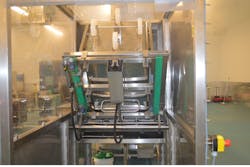Contaminant-Free Food Processing Starts at the Dock Door
“Keeping foods free of contaminants requires a lot more than just walls and doors and traffic flow,” says Farzad Shahsavarani, vice president of operations for Fresh Food Solutions at Chicago-based Flying Food Group. “Some processors don’t realize that contaminated containers entering the plant are exposing their products to environmental impurities and possible pathogens.”
FFG produces food destined for customers in the airline catering, grocery, food service and specialty markets. In a case study discussing container sanitization systems as part of the food safety mix, Shahsavarani says, “There is not always a clear understanding when we are talking about low-risk vs. high-risk or high-care areas in the food processing plant.”
When ingredients such as cheese, dough, shrimp or other outsourced ingredients are shipped, their outer packaging—whether buckets, bags or cans—is exposed to dirt, chemicalsTypically, this would involve the use of an automated system, such as a conveyor belt and spray tunnel. Known as a “barrier tunnel” or “sanitizing tunnel” in Europe, these systems convey the food container through a tunnel where a solution of sanitizing detergent is misted onto the items from top, bottom and sides before they are sent into the food processing plant and opened. FFG uses the Econosan, distributed by CM Process Solutions, Corona, Calif.
CM Process Solutions makes other container-sanitizing systems, including the ET 75 Tunnel Washing System. That’s something food processors may want to look into now that the U.S. Food Safety Modernization Act (FSMA), also called the Food Safety Act, has been passed.
The Food Safety Act gave the U.S. Food and Drug Administration (FDA) broader power to regulate any aspect of food production to provide a safer food supply. Some of the act’s goals will be accomplished by holding food production facilities more accountable for implementing safe and effective measures to prevent contamination. That means, in part, that conventional methods of cleaning and sanitizing, such as hand washing with power sprayers, are being re-evaluated.
Shahsavarani believes that, in the future, “it is very likely that higher global safety standards like GFSI [Global Food Safety Initiative] will come into play. This would include sanitation of food packaging.” Self-contained automated systems may be the way to go.
About the Author
Renee Bassett
Managing Editor

Leaders relevant to this article:
